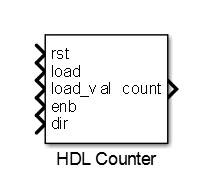HDL Counter
Free-running or count-limited hardware counter
Library
HDL Coder / Sources
Description
The HDL Counter block models a free-running or count-limited hardware counter that supports signed and unsigned integer and fixed-point data types.
The counter emits its value for the current sample time.
This block does not report wrap on overflow warnings during simulation. To report
these warnings, see the Simulink.restoreDiagnostic reference
page. The block does report errors due to wrap on overflow.
Control Ports
By default, the counter does not have input ports. Optionally, you can add control ports that enable, disable, load, reset or set the direction of the counter.
The table shows the priority of the control signals and how the counter value is updated in relation to the control signals.
Local reset, rst | Load trigger, load | Count enable, enb | Count direction, dir | Next Counter Value |
|---|---|---|---|---|
| 1 | – | – | – | initial value |
| 0 | 1 | – | – | load_val value |
| 0 | 0 | 0 | – | current value |
| 0 | 0 | 1 | 1 | current value + step value |
| 0 | 0 | 1 | 0 | current value - step value |
Count direction
The Step value parameter and optional count direction port,
dir, interact to determine the actual count
direction.
dir Signal Value | Step Value Sign | Actual Count Direction |
|---|---|---|
| 1 | + (positive) | Up |
| 1 | - (negative) | Down |
| 0 | + (positive) | Down |
| 0 | - (negative) | Up |
Parameters
- Counter type
Counter behavior.
Free running(default): The counter continues to increment or decrement by the Step value until reset.Count limited: The counter increments or decrements by the Step value until it is exactly equal to the Count to value.
- Initial value
Counter value after reset. The default is 0.
- Step value
Value added to counter at each sample time. The default is 1.
- Count to value
When the count is exactly equal to Count to value, the count restarts at the Initial value. This option is available when Counter type is set to
Count limited. The default is 100.- Count from
Specifies the parameter that sets the start value after rollover. When set to
Specify, the Count from value parameter is the start value after rollover. The default isInitial value.- Count from value
Counter value after rollover when Count from is set to
Specify. The default is 0.- Local reset port
When selected, creates a local reset port,
rst.- Load ports
When selected, creates a load data port,
load_val, and load trigger port,load.- Count enable port
When selected, creates a count enable port,
enb.- Count direction port
When selected, creates a count direction port,
dir.- Counter output data is
Output data type signedness. The default is
Unsigned.- Word length
Bit width, including sign bit, for an integer counter; word length for a fixed-point data type counter. The minimum value if Output data type is
Unsignedis 1, 2 ifSigned. The maximum value is 125. The default is 8.- Fraction length
Fixed-point data type fraction length. The default is 0.
- Sample time
Sample time. The default is 1.
This parameter is not available, and the block inherits its sample time from the input ports when any of these parameters is selected:
Local reset port
Load ports
Count enable port
Count direction port
Ports
The block has the following ports:
rstResets the counter value. Active-high.
This port is available when you select Local reset port.
Data type: Boolean
loadSets the counter to the load value,
load_val. Active-high.This port is available when you select Load ports.
Data type: Boolean
load_valData value to load.
This port is available when you select Load ports.
Data type: Same as
count.enbEnables counter operation. Active-high.
This port is available when you select Count enable port.
Data type: Boolean
dirCount direction. This port interacts with Step value to determine count direction.
1: Step value is added to the current counter value to compute the next value.0: Step value is subtracted from the current counter value to compute the next value.
This port is available when you select Count direction port.
Data type: Boolean
countCounter value.
Data type: Determined automatically based on Counter output data is, Word length, and Fraction length.
